- 1International Center for Tropical Agriculture, CIAT, Nairobi, Kenya
- 2Send a Cow-Kenya, Kakamega, Kenya
- 3Kenya Agricultural and Livestock Research Organization (KALRO), Kakamega, Kenya
Livestock productivity has remained low in sub-Saharan African countries compared to other places on the globe. The feeding component is the major limitation, in both quantity and quality. Among other inputs, feeding takes 55–70% of the costs involved. Livestock play a major role especially in smallholder mixed farms through provision of household nutrition and income through milk and meat. Equally, fertilization of cropland benefits from livestock manure, and livestock often act as insurance and savings by providing liquidity for unforeseen and urgent financial needs. Increasing livestock productivity would enhance the fore-mentioned benefits contributing to well-being and livelihoods. Toward this endeavor and with smallholder dairy farmers' participation, we undertook an evaluation of 10 selected forages from Urochloa Syn. Brachiaria and Megathyrsus syn. Panicum genus and compared them with Napier grass, i.e., Cenchrus purpureus Syn. Pennisetum purpureum commonly grown by farmers. For detailed and robust evaluation, we established the species in eight trial sites spread in four administrative counties in Western Kenya (Bungoma, Busia, Kakamega, and Siaya). In each site, the forages were established in plots in a randomized complete block design, replicated three times. Each site was linked to a group of farmers interested in dairy. For 2 years, dry matter production, plant height, and leaf-to-stem ratio was determined across all sites. Further, we guided farmers to generate participatory forage evaluation criteria, which they later administered across their respective forage demonstration sites individually on plot-by-plot basis to generate preference rating compared to what they normally grow—Napier grass. The results showed significant differences across the forage types within and between the sites. Cumulative dry matter yields ranged 13.7–49.9 t/ha over 10 harvestings across forage types and the counties, while values for crude protein were 1.85–6.23 t/ha and 110,222–375,988 MJ/ha for metabolizable energy. Farmer preferences emerged that highlighted forages with likely better chances of adoption with weighed scores ranging 5.5–7.6 against a scale of 1–9, across the counties. The observations provide additional and well-performing forage options for the farmers and possibly in similar production systems and ecologies. Awareness creation targeting livestock and dairy producers would be key, reaching, and informing them on alternative forage options, with potential to increase livestock productivity.
Introduction
Tenacious low livestock productivity in sub-Saharan African (SSA) countries is by and large due to inadequate feeding (Alejandro et al., 2007). Feeds and forages account for up to 70% of costs in livestock production (Odero-Waitituh, 2017). Hitherto, meat and milk demands in SSA are growing at 3.4 and 2.9% annually, respectively (Latino et al., 2020). As such, the estimated consumers' demand of 35 and 83 billion tons for meat and milk, respectively, by 2050 (World Bank, 2014) will remain a challenge unless livestock feeding is addressed. Land as a production resource is limited especially in intensifying smallholder systems, and it is no longer possible to allocate land for free grazing. However, cultivated forage presents a realistic avenue to meet ruminant roughage requirements under such circumstances. Albeit extensive forage catalogs exist, efforts toward forage improvement through selection and/or breeding are limited compared to food crops globally. In SSA this has resulted in use of non-nutritious crop residues (FAO, 2018) and limited forage options developed decades ago. Use of low nutritious roughages in turn results in undesirable high emission of methane gas per unit of product, associated with global warming (Makkar, 2016).
Therefore, there is need to identify and deploy improved forage technologies in SSA to bolster livestock productivity. Use of grasses from genus Brachiaria (now Urochloa) and Panicum (now Megathyrsus) present realistic options toward quality and quantitative roughage production. For example, use of Urochloa hybrids has been successful in Latin America, supporting improved livestock productivity, especially beef (Rivas and Holmann, 2005). With temporal and spatial variations to environments, matching forage genotypes to biophysical environment and agricultural context remains unsatisfactory in SSA. We therefore set out to evaluate the performance of selected grass lines from Urochloa and Megathyrsus under farmers' context in western Kenya. Involving farmers who are the end users is desirable as participation brings to the fore farmers' perspective on attributes/characteristics they use on choice of forages to grow and therefore guide on forage breeding and selection in order to meet desired traits. The importance of participatory approaches have been underscored (Abeyasekere, 2001), and for example, Mwendia et al. (2017a) used the same to evaluate oat varieties for forage production in central Kenya. Largely, western Kenya is moving toward intensified livestock production owing to high and growing human population coupled with land subdivision over generations reducing areas of free grazing (Waithaka et al., 2002). As such, there is limited grazing on natural pasture and there is a buildup on cattle in confinement under cut-and-carry systems. The genotypes Urochloa and Megathyrsus trace their origin in tropical Africa and only improved through selection and/or breeding (Cook et al., 2020). Therefore, the forages stand a good chance in fitting under cut-and-carry intensified systems. We hypothesized variable performance of these grasses under different locations and varying farmers' preference, results that would have potential to influence wider scaling of these grasses in western Kenya and beyond.
Materials and Methods
Site Selection
Four counties in western Kenya were selected based on their high bio-physical potential for dairy and commercialization, namely, Bungoma, Busia, Kakamega, and Siaya (Figure 1). Despite the areas being in mid-altitude 900–1,800 m, they differ agro-ecologically (Jaetzold et al., 2006). In addition, soils we analyzed from the specific trial sites showed significant differences in key soil attributes (Table 1). With a soil auger, we collected soil samples at 0–50 cm depth, and 3 samples along a replicate, hence 9 samples per site, and 72 samples from the 8 sites. In partnership with Send a Cow Kenya (SACK), a development partner, in these sites we linked up with farmer groups that have been engaged in SACK initiatives on improving human nutrition and incomes and selected two farmer groups with a keen interest in dairy per county, resulting in eight trial sites (Figure 1). Soil sample analysis was done at International Livestock Research Institute (ILRI), Nairobi, focusing on pH, total carbon, nitrogen, and phosphorus and contents of clay, sand, and silt.
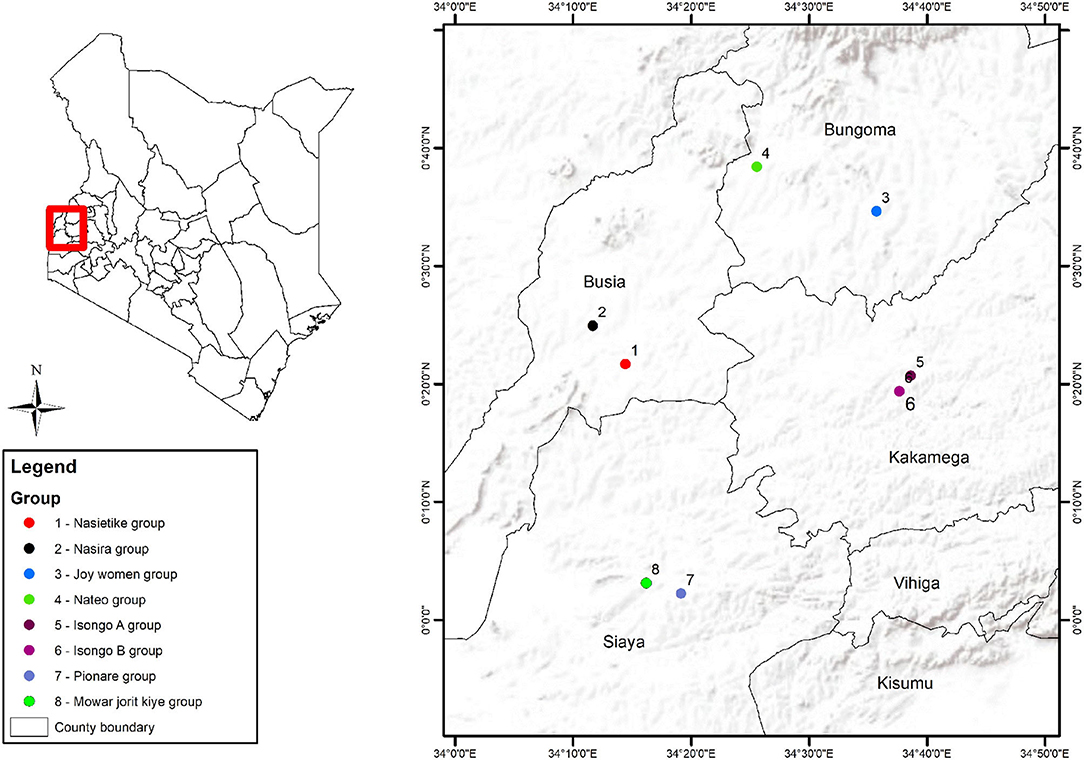
Figure 1. Experimental sites in Busia, Bungoma, Kakamega, and Siaya counties in western Kenya indicating farmer groups linked to the sites during the experiment in 2019–20.
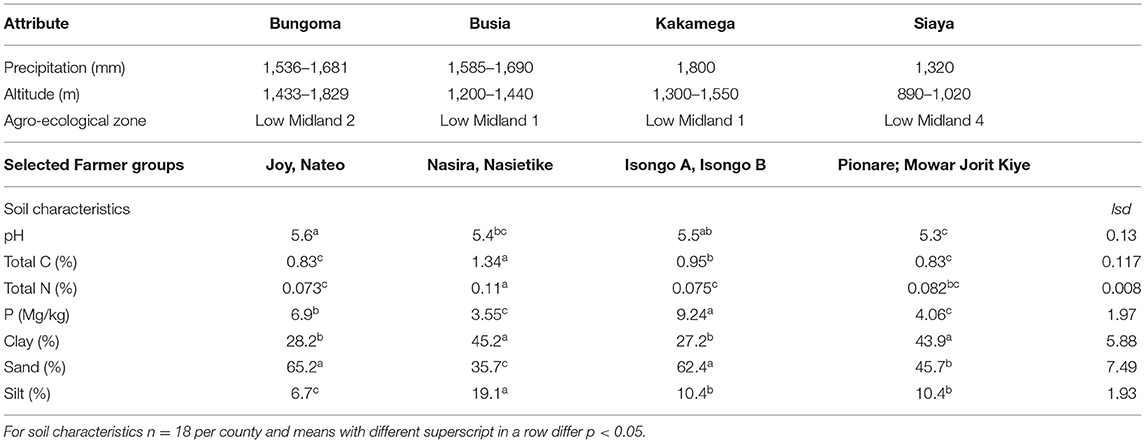
Table 1. Summary of rainfall, altitude, agro-ecological zones, soil characteristics, and farmer groups selected in the trial sites in Bungoma, Busia, Kakamega, and Siaya counties in western Kenya.
Forage Technologies, Trial Design, Planting, and Management
At the start of the project, we sensitized the selected farmer groups on dairy improvement and the importance of animal feeding. Consequently, we offered them to try out several forage options with potential to grow well in the region. In the end, the groups offered land where we established demonstration trials. While the project provided forage seeds and technical advice, farmers agreed to provide labor for land preparation, planting, weeding, harvesting, and monitoring the performance of the grasses. We selected 10 forage grasses covering 3 hybrids and 4 cultivars from genera Urochloa. The hybrids include Cayman, Cobra, and Mulato II and the cultivars Basilisk, Piata, Xaraes, and MG4. Xaraes and MG4 are also known as Toledo and La Libertad, respectively. For Megathyrsus genera, we included cultivars Mombasa, Tanzania, and Massai. Napier grass (Cenchrus purpureus Syn. Pennisetum purpureum) from the farmers' farms was included as a control. The trial design was a randomized complete block design with three replicates per site and in eight sites. Farmers manually prepared the land by digging with hoes to about 0.2 m depth. To get sufficiently fine seedbed, farmers broke down big soil clods to the required soil tilth. Using wooden pegs, we marked out 15 m2 plots (3 × 5 m) with 33 of them per site, to allow 3 replicates of the 11 grasses selected. Therefore, in the 4 counties we had 8 sites and 264 plots in total. Because of acidic soils in western Kenya (Kanyanjua et al., 2002), we applied lime at 2 t/ha prior to planting. At planting in May 2018, we randomly allocated the grasses to the prepared plots. We used the recommended seed rate for each genus, i.e., 6 kg/ha for Urochloa (Njarui et al., 2016) and 3 kg/ha for Megathyrsus, while for Napier grass we used splits spacing at 1 × 1 m grids (Mwendia et al., 2017a,b). We applied NPK inorganic MEA fertilizer® (NPK fertilizer 23:23:0) at the rate of 50 kg N/ha. Because of small seed size in Urochloa and Megathyrsus, shallow hills of about 0.02 m depth, 0.3 m between hills in a row, and 0.45 m row-to-row for Urochloa were used, and shallow furrows of about 0.02 m depth spaced at 0.3 m row to row for Megathyrsus. After planting, farmers manually maintained plots weed-free as necessary. The grasses took 3 months to establish, and standardization cut was done in September 2018.
Forage Participatory Evaluation and Dry Matter Yield Measurements
In each of the counties we selected one group (Nasietike, Joy, Mowar Jorit Kiye, Isongo B) to undertake participatory evaluation at the demonstration sites. The evaluations took place when the forages had established well and just before the third harvesting (described below). We guided each of the four farmer groups in developing criteria that describe the attributes they prefer in a forage grass. On a scale of 1–9, the farmers as a group scored each criterion where 1 = least important and 9 = most important (Mwendia et al., 2017a). Subsequently, each farmer was provided with a printed sheet containing 33 plots numbered serially in a column and the criteria developed by the group earlier along the topmost row. At the demonstration site, each farmer scored each plot across all the criteria, until all the plots were complete. We collected all data sheets for later weighted score analysis (Abeyasekere, 2001).
For dry matter yields the first harvest after standardization was January 2019. We allowed growth cycles of about 8 weeks (Njarui et al., 2016) after which the grasses were harvested at a stubble height of about 5–10 cm. Before cutting, we randomly selected and measured plant height of five tillers in each plot from the soil level to the tip of the topmost standing height. Fresh yield weight was measured with a digital weighing balance (KERN CH 50K50 with 10 g precision) and recorded on plot-by-plot basis each measuring 15 m2. A sample of about 450 g per plot was randomly selected after mixing thoroughly the whole harvested biomass from each plot, for dry matter content determination. The sample as weighed and put inside a sample bag labeled and taken to the International Center for Tropical Agriculture (CIAT) sample processing room in Kisumu, western Kenya. Samples were manually separated into leaves and stems, labeled, and dried in an oven at 65°C for 48 h to determine dry matter content and leaf: stem ratio. Corresponding leaf and stem samples were combined back for further nutrition analysis (described below). The process was repeated for 10 consecutive cuttings, running in 2019 and 2020 except for nutritional analysis done only for the third harvest that had undergone rain season.
Forage Nutritive Value Determination
Dried samples were ground to pass through 1 mm sieve, packed in plastic zip-lock bags and sent for near-infrared-system (NIRs) analysis at Crop Nutrition Laboratory Services Ltd, Limuru, Kenya (https://cropnuts.com/service/animal-feed-analysis/). Analysis targeted metabolizable energy (ME), crude protein (CP), and in vitro organic matter digestibility (IVOMD).
Data Analyses
All data were managed in Microsoft Excel, and statistical analysis was carried out in GenStat 18th edition. We carried out repeated measures analyses of variance (ANOVA) where fixed variables included harvest number/time, site/location, and test forage grasses, while response variables included plant height, dry matter yields, leaf:stem ratio, ME, CP, and digestible organic matter, with the means separated by least significance difference (lsd). For the participatory evaluation we pooled individual scores by farmers and multiplied with the criteria scoring by the group, to generate weighted scores (Abeyasekere, 2001; Mwendia et al., 2017a) and subsequent ranking of the forages on county-by-county basis.
Results
Analysis of Variance Summary Across Main Effects and Interactions
Significant differences were found in all traits for both county and forage grass type (Table 2). Where interactions were observed, we focused on their means for results and discussion.
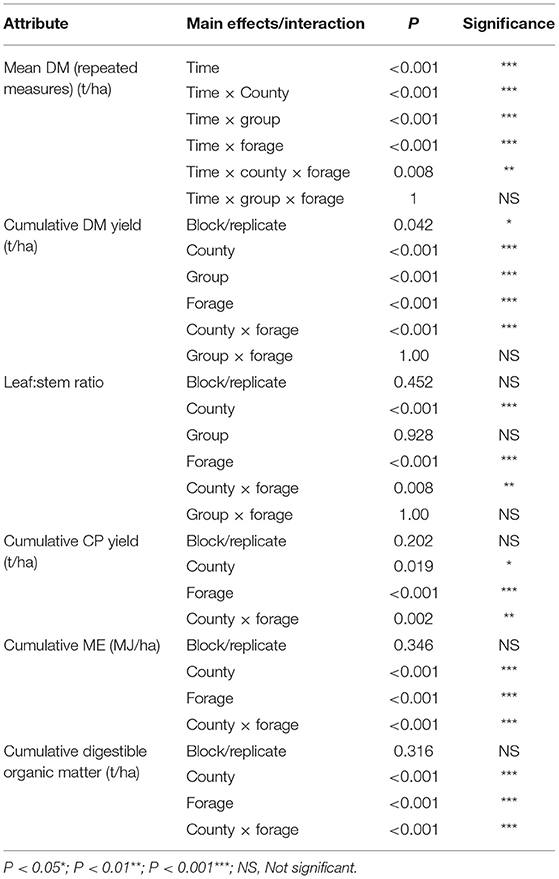
Table 2. Significance of main effects and interactions for cumulative dry matter yields, leaf:stem ratio, cumulative crude protein yield, metabolizable energy, and digestible organic matter.
Soil Characteristics and Dry Matter Yields
The soils were significantly acidic in Siaya (p <0.05) than Bungoma and Kakamega (Table 1). Busia had greater carbon and nitrogen content than the other counties but had the least phosphorus content, only similar to Siaya. By the proportions (%) of clay, sand, and silt, soil types in the sites were found to be as follows: sandy–clay–loam, clay, sandy–clay–loam, and sandy–clay for Bungoma, Busia, Kakamega, and Siaya, respectively. The mean dry matter per harvest showed significant differences across the harvests and interactions between sites and harvest, forage genotype and harvest, and sites and forage genotype (Table 3). The second and third harvests showed the least and greatest dry matter yields, respectively. In Bungoma and Busia sites, the second and fourth harvests presented the least and greatest dry matter yields, respectively, unlike in Kakamega and Siaya where the greatest biomass yield was in the third and seventh harvests, respectively. On forage genotype–harvest interaction, forage type producing the most dry matter yield varied across the harvestings. In the first harvest, Basilisk produced most, and Napier grass in second and third. From the fourth to the tenth harvests, Massai dry matter yield surpassed all the others except in the ninth harvest wherein Napier grass produced the most. On site–forage interaction, the most dry matter production was from Xaraes in Bungoma and Massai for Busia, Kakamega, and Siaya.
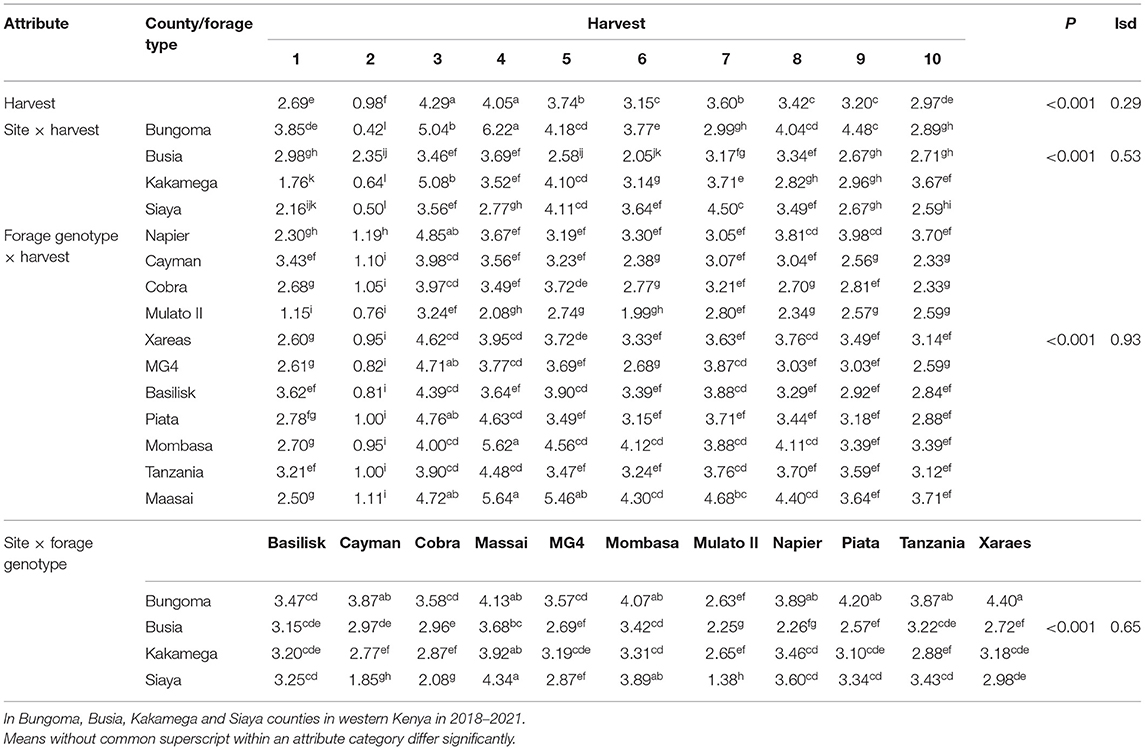
Table 3. Mean dry matter yields (t/ha) per harvest over ten harvests and interactions for site × harvest, forage genotype × harvest, and site × forage genotype for 3 Urochloa hybrids (Cayman, Cobra, Mulato II) 4 Urochloa cultivars (Basilisk, MG4, Piata, Xareas), 3 Megathyrsus cultivars (Maasai, Mombasa, Tanzania) and Napier grass.
Cumulative dry matter yields over 10 cuttings showed interaction between the county and the grasses. Generally, across the counties the order of dry matter yield was Bungoma > Kakamega > Busia > Siaya (Figure 2). In Joy group site in Bungoma, Napier grass produced more biomass than Mulato II, MGA, and Basilisk but similar to the other grasses. This was different for Nateo group in the same county, where Napier grass only produced more than Mulato II but significantly less than Cayman, MG4, Xaraes, Piata, Tanzania, Mombasa, and Massai. In this site, Xaraes accumulated the most biomass significantly greater than all the grasses, except similar to Massai cultivar. In Busia County and at Nasietike group site, Napier grass produced the least biomass against all the other grasses. Megathyrsus cv Massai produced the most, significantly greater than all grasses, except similar to Basilisk and Mombasa. In Busia the second site, Nasira group, maintained the yield pattern for the grasses. Although Napier grass accumulated the least, it was similar to all the other grasses except for the three Megathyrsus species, Cayman, and Basilisk that produced significantly greater biomass. In Kakamega County and at Isongo A group site, Basilisk accumulated greater biomass than all grasses except for Megathyrsus cv Massai which had similar biomass. Among Urochloa hybrids, only Cayman had similar biomass to Napier grass. At Kakamega second site, Isongo B, Napier grass produced similar biomass to Mombasa and Massai, and the rest had significantly lower biomass (Figure 2). In this site, Megathyrsus cv Massai accumulated most dry matter significantly. In Siaya County and at Mowar Jorit Kiye farmer group site, Megathyrsus cv Massai accumulated the greatest biomass only similar to Napier grass but significantly greater than all the other grasses. The three Urochloa hybrids accumulated significantly low biomass than all the Urochloa cultivars, Megathyrsus cultivars, and Napier grass. In the second site of this county, Megathyrsus cv Mombasa accumulated greater biomass than all the other grasses, while the three Urochloa hybrids accumulated the least (Figure 2).
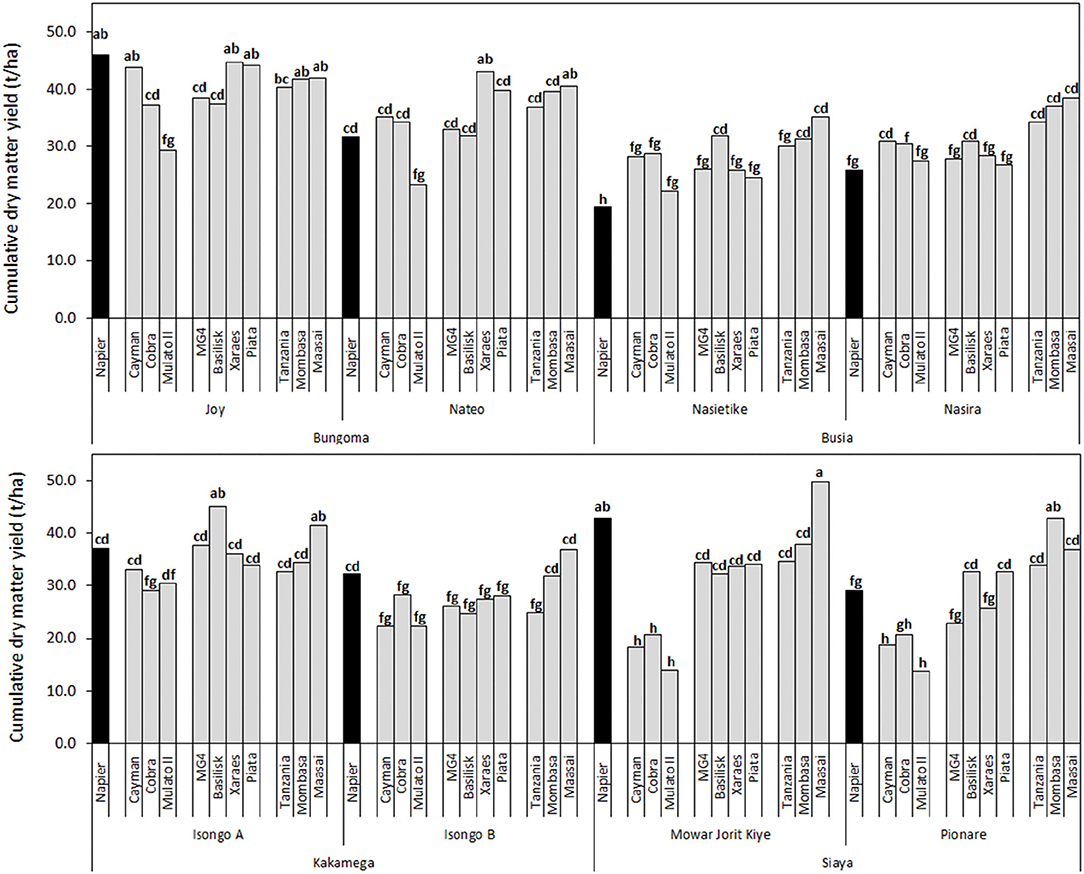
Figure 2. Mean cumulative dry matter yield t/ha over 10 harvestings in 2 years, for 3 Urochloa hybrids, (Cayman, Cobra, Mulato II), 4 Urochloa cultivars (MG4, Basilisk, Piata, Xaraes) and 3 Megathyrsus cv (Mombasa, Tanzania, Maasai), compared to Napier grass in four counties, each with two farmer groups namely, Bungoma (Joy, Nateo), Busia (Nasietike, Nasira), Kakamega (Isongo A, Isongo B) and Siaya (Mowar Jorit kiye, Pionare) in western Kenya. Bars with different letter differ significantly p < 0.05.
Plant Height, Leaf–Stem Ratio, Crude Protein, and Metabolizable Energy
Plant height significantly varied across counties and forage grasses (Table 4). Napier grass and Mulato II consistently had tall and short plants, respectively. However, the order was Napier grass > Mombasa > Tanzania > Massai > Xaraes > Basilisk ≈ MG4 > Piata > Cobra > Cayman > Mulato II. Leaf:stem ratio varied within and between counties. Across the counties, only Mulato II hybrid, Xaraes cultivar, and the three Megathyrsus attained leaf:stem ratio of 2. In Bungoma and Busia Counties, Mulato II attained the highest, Megathyrsus cv Mombasa in Kakamega, and Megathyrsus cv Massai in Siaya. The least leaf:stem ratio was by Napier grass in Bungoma and Basilisk in the other three counties.
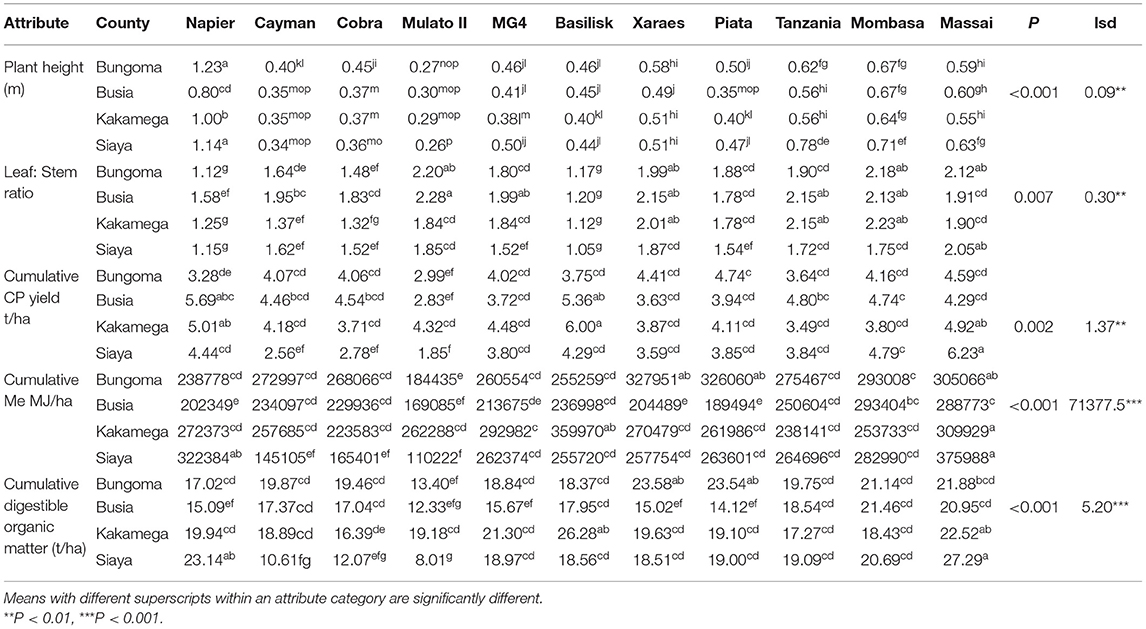
Table 4. Mean plant height (m), leaf to stem ratio, crude protein (t/ha), metabolizable energy (ME MJ/ha), and digestible organic matter (t/ha) for Napier grass, Urochloa hybrids (Cayman, Cobra, Mulato II), Urochloa cultivars (MG4, Basilisk, Xaraes, Piata), and Megathyrsus cultivars (Tanzania, Mombasa, Maasai) over 10 harvestings in 2019 and 2020 in western Kenya.
CP yield (t/ha) varied across the grasses and within and between counties (Table 4). In Bungoma most of the grasses produced statistically similar CP yield including Piata, Massai, Mombasa, Tanzania, Xaraes, Basilisk, MG4, Cobra, and Cayman. Mulato II and Napier grass accumulated statistically low CP yield compared to Piata. In Busia County, there was a change in the order. Napier grass produced the most that was statistically similar to those of Cayman, Cobra, Basilisk, Tanzania, Mombasa, and Massai. Only Mulato II, MG4, Xaraes, and Piata have statistically low CP yield compared to Napier grass. In Kakamega, cultivar Piata accumulated the most CP yield statistically greater than all the other grasses except for Napier grass and Megathyrsus cv Massai. In Siaya, Megathyrsus cv Massai yielded the most CP that was statistically greater than for all the other grasses (Table 4).
Cumulative ME yield (MJ/ha) varied cross the counties and among grasses (Table 4). In Bungoma, Xaraes accumulated the most that was statistically greater than all the grasses except for Piata and Massai. In Busia County, Megathyrsus cv Mombasa accumulated the most that was statistically greater than those of Piata, MG4, Mulato II, and Napier grass but similar to the other grasses. In Kakamega County, Basilisk accumulated statistically greater ME than all the grasses except Megathyrsus cv Massai. Hybrid Cobra produced the least in the county compared to other grasses. In Siaya County, Megathyrsus cv Massai accumulated statistically greater ME than all the grasses except Napier grass, while Mulato II produced the least.
On cumulative digestible matter in Bungoma County, Xaraes produced the most and statistically more than Napier grass and Mulato II (Table 4). Although Mulato II had the least, it was similar to that of Napier grass and Basilisk. In Busia County, the order was different. Megathyrsus cv Mombasa had the most digestible organic matter, statistically greater than those of Napier grass, Mulato II, MG4, Xaraes, and Piata. This was unlike in Kakamega County where Basilisk had the most and statistically greater than all the other grasses except for MG4 and Megathyrsus cv Massai. In Siaya County, Megathyrsus cv Massai accumulated the most and similar to Napier grass. The values for Mulato II were the lowest in this county and by 3.4 times compared to Megathyrsus cv Massai.
Participatory Evaluation
To connect biophysical performance of the grasses with end-users, we undertook farmers' participatory evaluation. Farmers from the counties and linked to the trial site's groups developed criteria that were closely related as follows. Nasietike from Busia identified disease tolerance, fast germination, fast regrowth, high germination rate, leafiness, more milk, softness, upright growth, drought tolerance, high biomass, and palatable as key considerations. This was similar for the other groups except Bungoma Joy group, which did not identify upright growth while Siaya's Mowar Jorit Kiye and Kakamega's Isongo B groups identified greenness that was not identified by Nasietike or Joy. Pooled ratings across the groups and by grass type varied (Figure 3). According to Nasietike group the order of preference emerged as Cayman >Xareas > Cobra ≈ Mombasa > Tanzania > Piata Massai ≈ Mulato II > MG4 > Napier ≈ Basilisk. For Joy group the order started the same as Nasietike for the first two but followed by interchange of the subsequent grasses. The order was Cayman > Xaraes > MG4 ≈ Mombasa > Piata > Basilisk > Cobra > Massai ≈ Tanzania > Mulato II > Napier. In Siaya by Mowar Jorit Kiye group the order sorted differently as Cobra ≈ Napier > Xaraes > Piata ≈ MG4 > Cayman > Massai > Mombasa > Mulato II > Basilisk > Tanzania. Kakamega by Isongo B further presented a different order as MG4 ≈ Mulato II ≈ Massai > Basilisk > Cayman ≈ Cobra ≈ Piata ≈ Tanzania > Napier > Mombasa > Tanzania (Figure 3).
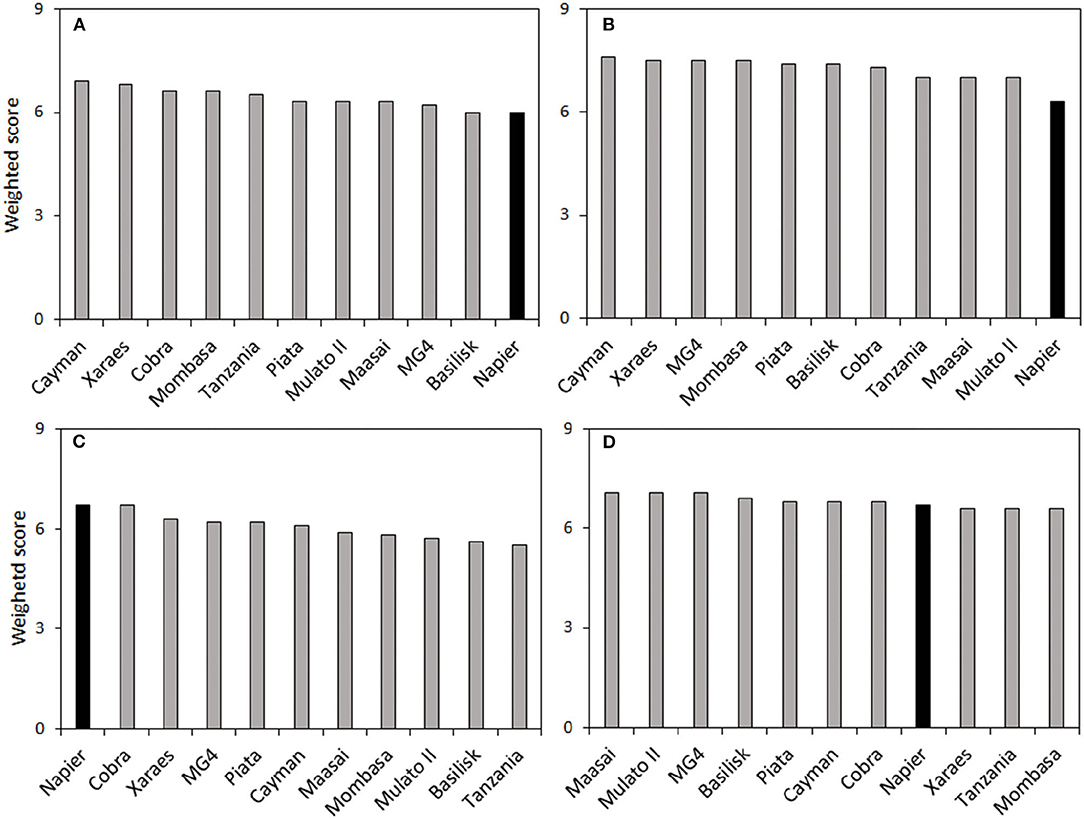
Figure 3. Weighted Scores on 1–9 scale, where 1 = least important, 9 = most important against forage grass types for Nasietike farmer group (A), Joy farmer group (B), Mowar Jorit Kiye farmer group (C,D) Isongo B farmer group before third harvesting in 2019 in western Kenya.
Discussions
The overall objective of identifying performance of the different forages in different locations and engaging the end users was met. Indeed, in western Kenya with trial sites characterized by temporal and spatial differences, the sites equally showed variable performance (Tables 2–4) and farmers' ratings (Figure 3). The results present important information that would connect well with intensions of improving forage production in the region, to contribute to improved livestock productivity especially cattle under the smallholder mixed farming in the area. The importance of matching forage with biophysical environment and agricultural context is reported in previous research efforts (Tilman et al., 2011; Mwendia, 2015), and this work adds onto the basket of options toward this endeavor.
Dry matter yields realized in the study show the grasses and performance in the different sites. Clearly, a grass doing well in one location did not necessarily do so in another location. This is governed by grass genotype–environment interaction with environmental attributes including temperatures, soil type, and rainfall coming into play. Even within areas that are in close proximity, differences are likely to emerge because of transient conditions that may exist in one site and not the other. For example, while Napier grass at the Joy site in Bungoma accumulated significantly greater biomass than other grasses (Figure 2), this was remarkably reversed in Nateo site in the same county. The essence of placing the grass technologies in an agricultural context, therefore, serve to get the actual performance to inform recommendations, rather than providing generalized recommendations, but advise based on empirical evidence derived. As such, it would not be advisable to grow Urochloa hybrids in Siaya and other areas similar to the site, but the Megathyrsus or Urochloa cultivar stands a better chance. While Napier grass is the most grown fodder in the study counties (Khan et al., 2014), results here show that it does not produce well in Busia compared to the Urochloa and Megathyrsus varieties considered in this case study, indicating the latter two could successfully be used for livestock by producers in the area. However, in Joy and Mowar Jorit Kiye sites, Napier grass would be more advantageous especially on dry matter quantity than either Cobra, Mulato II, MG4, Basilisk, and all the other grasses except Massai for the two sites respectively. The suitability of the Megathyrsus and Urochloa grasses in the current study clearly emerged. Specifically, in Busia County, Cayman, Cobra, Massai, Tanzania, and Mombasa are better options than Napier grass, especially in Nasietike site. In Kakamega and similar ecologies to the study sites, Basilisk could be a grass of choice at Isongo A site and Megathyrsus cv Massai in Isongo B. Equally, Massai would also be a cultivar of choice at Mowar Jorit Kiye and Mombasa at Pionare site, both in Siaya County. Choice of cultivar could make a huge difference in bridging the forage quantity gap, which is often characteristic in intensified mixed smallholder systems in SSA (FAO, 2018). As observed in Busia, the cultivar Massai nearly doubled the biomass of Napier grass, which means providing roughage for nearly double the number of feeding days of Napier grass. Similarly, in Bungoma, Mulato II and Xaraes outperformed Napier grass (Figure 2). Any extra biomass production from the same unit of land is preferable, demonstrating improved resource-use efficiency, key especially in the face of global warming (Makkar, 2016). Extra feeding days for dairy producers translate into extra milk yield and a clear livelihood benefit.
While all the forage grasses in this study follow the C4 photosynthetic pathway, being tropical grasses, their differences in performance could most probably be explained by physiology and/or adaptations that were not measured in the current study. For example, the grasses doing well in the relatively dry areas are likely to have better stomatal control when faced with limited soil moisture, exhibit osmotic adjustment, or may be accumulating greater root biomass to aid in nutrient and water exploration (Mwendia et al., 2013). Having greater leaf area index could also be beneficial in intercepting more light for photosynthesis and hence growth. Equally, some of the grasses have better nutrient and water use efficiency. This is an area worth investigating further in a physiological study to unravel key drivers responsible for the differences observed.
While plant height is positively correlated with biomass, and inversely with forage quality (Tessema et al., 2010), plant height also has implications especially where manual forage harvesting is practiced in smallholder farms (Mwendia et al., 2017a,b). For the 11 grasses evaluated, none exhibited prostrate growth habit, and all had upright tillers. Tall plants facilitate easier handling/grasping when cutting to the required stubble height. In this regard, Napier grass, the Megathyrsus and Urochloa cultivars, and the hybrids, in that order, would suit manual harvesting by farmers. However, there is a need to compromise and ensure forages are not allowed to overgrow as quality deteriorates. Although we did not report neutral detergent fiber, it is usually negatively correlated with organic matter digestibility (Roche et al., 2009); thus, the lower values for digestible organic matter (Table 4) suggest greater neutral detergent fiber.
Mulato II with slightly less than a foot height would be relatively difficult for proper hand grip during harvest, which may make it less attractive in smallholder cut-and-carry systems. However, Mulato II's leafiness, an attribute important in ruminants, as they select for leaves as opposed to stems (Mwendia et al., 2017b), is preferable. Short forages could fit better in systems where cattle graze directly without trampling that could lead to forage wastage/losses. Forage improvement, e.g., breeding, should therefore take into consideration the traits that fit under a given agricultural context as explained, in smallholder cut-and-carry systems.
Despite the low plant height for Mulato II, its great leaf:stem ratio compensates for its relatively low biomass yield, as most nutrients are in the leaves, and in effect the CP yield, ME, and digestible organic matter were similar to most of the grasses, e.g., in Kakamega and Bungoma. As such, Mulato II presents good quality also often a challenge in livestock production, and breeding for leafiness in forage would be preferable. While harvesting could pose a challenge to smallholder livestock producers dealing with Mulato II, its good quality should warrant investigating and devising cheap tools that could help in harvesting and make it friendly to grow.
The ratings by farmers (Figure 3) largely relied on what they could discern phenotypically, and it is interesting to note that this assessment is fully in line with the quantified physical and laboratory assessment. For example, in the Nasietike group from Busia where they ranked Cayman, Xaraes, Cobra, and Mombasa highly, we see that the same varieties also did well on leaf:stem ratio, plant height, CP and ME yields, and digestible organic matter (Table 4). This underscores the importance of including farmers' preferable traits in forage selection and breeding, to end with products that adapt to not only ecological niche but agricultural content under consideration. Participatory evaluation would indicate high chances of adoption, while good biophysical characteristics ensures that this adoption also has a positive impact on livestock productivity.
Conclusions
In situ evaluation of the forages revealed how the forages perform on biomass production, quality, and farmers' preferences. A mixed order of performance emerged from the study sites. While Napier grass is the prevalent forage grown across the study sites, evidence we show here reveals that there are alternative forage grasses that can be grown and provide great and quality roughages for ruminant production. In Siaya, which is relatively dry, the Megathyrsus, Napier grass, and Urochloa ecotypes are better suited. However, in Busia, Napier grass is least suitable with options of Urochloa hybrids (Cayman and Cobra) and the three Megathyrsus cultivars being better possibilities. All the grasses except Mulato II performed well in Bungoma, of which the farmers prefer Cayman, Xaraes, MG4, and Mombasa. In Kakamega, both the farmers' selection and agronomic performance indicate the virtuous grasses would be Megathyrsus cv Massai, Urochloa cultivars Basilisk and MG4, and Urochloa hybrid Mulato II. It is paramount that future forage selection and breeding take into consideration farmers' preferable traits in a given agricultural context. Following forage evaluation for 2 years and farmers' involvement, the inferences we believe provide a strong basis for practical implementation and promotion of the forages in the areas and by extension in other similar ecologies.
Data Availability Statement
The raw data supporting the conclusions of this article will be made available by the authors, without undue reservation.
Author Contributions
The authors participated in various ways regarding the work reported in the manuscript and they have all agreed the manuscript to be summited to Frontiers special issue on forages. SM designed and established the trials, analyzed data, and wrote the manuscript. RO participated in data collection and engaging the farmers. AJ identified the farmers groups discussed the trials and also engaged the farmers during the trials. DM participated in engaging farmers and observing agronomic measures in the trials and editing the manuscript. AN participated in design of the trial and engaging the partners during the trial as well as writing the manuscript. All authors contributed to the article and approved the submitted version.
Funding
This work received financial support from the German Federal Ministry for Economic Cooperation and Development (BMZ) commissioned and administered through the Deutsche Gesellschaft für Internationale Zusammenarbeit (GIZ) Fund for International Agricultural Research (FIA), Grant Number: 81219431, which is highly appreciated.
Conflict of Interest
The authors declare that the research was conducted in the absence of any commercial or financial relationships that could be construed as a potential conflict of interest.
The handling editor is currently editing co-organizing a Research Topic with the author AN and confirms the absence of any other collaboration.
Publisher's Note
All claims expressed in this article are solely those of the authors and do not necessarily represent those of their affiliated organizations, or those of the publisher, the editors and the reviewers. Any product that may be evaluated in this article, or claim that may be made by its manufacturer, is not guaranteed or endorsed by the publisher.
Acknowledgments
We want to acknowledge the farmers who took their time and showed interest in the forages, without which this work would not be complete. The Send a Cow—Kenya staff who participated in one way or another on following the forage trials in different locations in western Kenya is highly appreciated.
References
Abeyasekere, A. (2001). Analysis Approaches in Participatory Work Involving Ranks and Scores. Reading: Statistical Services Centre, University of Reading. Available online at http://www.reading.ac.uk/ssc/ (accessed February 23, 2021).
Alejandro, N., Ehui, S., and Benin, S. (2007). Livestock productivity in developing countries: an assessment. Handbook of Agricultural Economics 3, 2461–2532. doi: 10.1016/S1574-0072(06)03047-7
Cook, B. G., Pengelly, B. C., Schultze-Kraft, R., Taylor, M., Burkart, S., Cardoso Arango, J. A., et al. (2020). Tropical Forages: An Interactive Selection Tool. 2nd and Revised Edn. International Center for Tropical Agriculture (CIAT), Cali, Colombia and International Livestock Research Institute (ILRI), Nairobi, Kenya. www.tropicalforages.info.
Jaetzold, R., Schimidt, H., Hornetz, B., and Shisanya, C. (2006). Farm Management Handbook of Kenya Vol. II. Natural Conditions and Farm Management Information, 2nd edn. Nairobi: Ministry of Agriculture.
Kanyanjua, S. M., Ireri, L., Wambua, S., and Nandwa, S. M. (2002). Technical, Kari and Note No. 2002. “TecNote11.” (11).
Khan, Z. R., Midega, C. A. O., Nyang'au, I. M., Murage, A., Pittchar, J., Agutu, L. O., et al. (2014). Farmers' knowledge and perceptions of the stunting disease of napier grass in western kenya. Plant Pathol. 63, 1426–1435. doi: 10.1111/ppa.12215
Latino, L. R., Ciamarra, P., and Wisser, D. (2020). Africa: The livestock revolution urbanizes. Global Food Security 26. doi: 10.1016/j.gfs.2020.100399
Makkar, H. P. S. (2016). Animal nutrition in a 360-degree view and a framework for future RandD work: towards sustainable livestock production. Animal Produc. Sci. 56, 1561–1568. doi: 10.1071/AN15265
Mwendia, S. W. (2015). Physiological and Productivity Evaluation of Napier Grass ('Pennisetum purpureum' Schumach.) Cultivars Under Variable Water Supply, Temperature and Carbon Dioxide Conditions. Ph.D. thesis, University of New England, Australia. Available online at: https://hdl.handle.net/1959.11/18376
Mwendia, S. W., Maass, B. L., Njenga, D. G., Nyakundi, F. N., and Notenbaert, A. M. O. (2017a). Evaluating oat cultivars for dairy forage production in the central kenyan highlands. African J. Range Forage Sci. 34. Available online at: http://www.tandfonline.com/loi/tarf20
Mwendia, S. W., Yunusa, I. A. M., Sindel, B. M., Whalley, R. D. B., and Kariuki, I. W. (2017b). Assessment of napier grass accessions in lowland and highland tropical environments in East Africa: productivity and forage quality. Exp Agricult. 53, 27–43. doi: 10.1017/S001447971600003X
Mwendia, S. W., Yunusa, I. A. M., Whalley, R. D. B., Sindel, B. M., Kenney, D., and Kariuki, I. W. (2013). Use of plant water relations to assess forage quality and growth for two cultivars of napier grass (Pennisetum purpureum) subjected to different levels of soil water supply and temperature Regimes. Crop Pasture Sci. 64, 1008–1019. doi: 10.1071/CP13254
Njarui, D. M. G., Gichangi, E. L. M., and Gatheru, M. (2016). “Biophysical environment and farming systems of selected regions for integrating brachiaria grasses in Kenya,” in Proceedings of the Workshop Held in Naivasha, Kenya.
Odero-Waitituh, J. A. (2017). Smallholder dairy production in Kenya; a review. Livestock Res, Rural Dev. 29:139. Available online at: http://www.lrrd.org/lrrd29/7/atiw29139.html
Rivas, L., and Holmann, F. (2005). Potential economic impact from the adoption of new Brachiaria hybrids resistant to spittlebugs in livestock systems of Colombia, Mexico and Central America. Livestock Res. Rural Dev. 17, 1–21. Available online at: http://www.lrrd.org/lrrd17/5/holm17054.htm
Roche, J. R., Turner, L. R., Lee, J. M., Edmeades, D. C., Donaghy, D. J., Macdonald, K. A., et al. (2009). Weather, herbage quality and milk production in pastoral systems. 2. Temporal patterns and intra-relationships in herbage quality and mineral concentration parameters. Anim. Produc. Sci. 49, 200–210. doi: 10.1071/EA07308
Tessema, Z. K., Mihret, J., and Solomon, M. (2010). Effect of defoliation frequency and cutting height on growth, dry matter yield and nutritive value of Napier grass (Pennisetum purpureum (L.) Schumach). Grass Forage Sci. 65, 421–430. doi: 10.1111/j.1365-2494.2010.00761.x
Tilman, D., Balzer, C., Hill, J., and Befort, B. L. (2011). Global food demand and the sustainable intensification of agriculture. Proc. Natl. Acad. Sci. U.S.A. 108, 20260–20264. doi: 10.1073/pnas.1116437108
Waithaka, M. M., Nyangaga, J. N., Staal, S. J., Wokabi, A. W., Njubi, D., Muriuki, K. G., et al. (2002). Characterization of Dairy Systems in the Western Kenya Region. Report of Dairy and Crop Characterisation Activities in Western Kenya. Smallholder Dairy (RandD) Project P.O. Box 30028 Nairobi, Kenya.
World Bank (2014). Business and Livelihoods in African livestock. Available online at: http://www.fao.org/3/a-i3724e.pdf
Keywords: leaf to stem ratio, farmer evaluation, forage quality, dry matter yield, forage grass
Citation: Mwendia SW, Odhiambo R, Juma A, Mwangi D and Notenbaert A (2021) Performance of Urochloa and Megathyrsus Forage Grasses in Smallholder Farms in Western Kenya. Front. Sustain. Food Syst. 5:719655. doi: 10.3389/fsufs.2021.719655
Received: 02 June 2021; Accepted: 02 November 2021;
Published: 15 December 2021.
Edited by:
Stefan Burkart, Alliance Bioversity International and CIAT, FranceReviewed by:
Sarah Palmer, Aberystwyth University, United KingdomJuan De La Cruz Jiménez, Nagoya University, Japan
Sara Stephanie Valencia Salazar, The South Border College (ECOSUR), Mexico
Copyright © 2021 Mwendia, Odhiambo, Juma, Mwangi and Notenbaert. This is an open-access article distributed under the terms of the Creative Commons Attribution License (CC BY). The use, distribution or reproduction in other forums is permitted, provided the original author(s) and the copyright owner(s) are credited and that the original publication in this journal is cited, in accordance with accepted academic practice. No use, distribution or reproduction is permitted which does not comply with these terms.
*Correspondence: Solomon Waweru Mwendia, cy5td2VuZGlhQGNnaWFyLm9yZw==
 Solomon Waweru Mwendia
Solomon Waweru Mwendia Ruth Odhiambo
Ruth Odhiambo Alfred Juma2
Alfred Juma2 David Mwangi
David Mwangi An Notenbaert
An Notenbaert